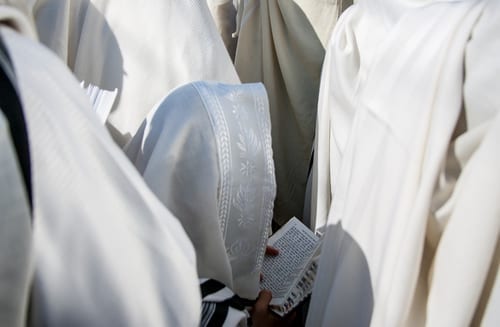As we approach Yom Kippur we recognise that there is a great necessity to contemplate our shemiras hamitzvos – where we have erred and where we need to do teshuva. However there is another vital aspect of Avodas Hashem that we are less aware of, that we also need to analyse: In the tefillas for the Yamim Noraim we state that man is judged, ‘maaseh ish u’pekudaso’. ‘Maaseh ish’ refers to one’s shemiras hamitzvos but what does ‘pekudaso’ mean?
Rav Shraga Feivel Mendlovitz zt”l explains that ‘pekudaso’ refers to man’s tafkid, his purpose in this world. Every individual is placed in this world with a specific job to accomplish and he is judged according to whether he devoted enough effort into reaching this goal. Even if a person has kept all the mitzvos, he may still be taken to task if he did not fulfil his potential. It seems that this Avoda is even more difficult than that of shemiras hamitzvos as is seen by the following examples.
When the Netziv completed his commentary on the Sheiltos, ‘Emek Sheila’ he made a seuda, partly because that is the custom when one completes a sefer but he had another, more personal reason. He related that when he was a boy he was not particularly serious about his Torah studies. His parents made every effort to help him change his attitude but to no avail. One day he overheard his parents discussing his lack of success in Torah learning – they decided that he had no prospect of becoming a Talmid Chacham and therefore he should learn to become a cobbler. They hoped that at least he would be a yirei shamayim who would go about his work with honesty and dedication. When he heard this, it shocked him greatly and he decided to take his Torah studies seriously – this event had such an impact on him that it led to a complete change in his attitude and he became a Gadol, he was Rosh Yeshiva of Volozhin and wrote a number of classic sefarim. Imagine if he had never had this change of attitude and he would have become a simple cobbler who observed Torah and Mitzvos with genuine yiras shamayim. He would have gone up to shamayim confident that he had led a Torah true lifestyle, keeping the mitzvos, and being kovaya ittim l‘Torah. Instead they would have shown him the Emek Sheila, he would look at it and have no understanding of its content. They would ask him, where’s your Emek Sheila, where are all the sefarim that you could have written? He would have lived his life with no idea of what he could have become. It was only through a dramatic change in his attitude that he was able to reach his true potential – to be a Gadol b’Yisroel.
There are other allusions to this concept in the Yom Kippur davenning. At Mincha we read Maftir Yonah – what is the significance of the story of Yonah for Yom Kippur? Of course it teaches us about teshuva but the Mishna Berurah brings another connection. Yonah shows us that “one cannot escape from Hashem.”[1] He elaborates in the Shaar Hatzion; sometimes a person gives up in life, feeling that he cannot achieve what he is meant to, “however, this is a mistake, for eventually, everything that Hashem wants this soul to fix, he must fix, and return many times to Olam Hazeh [in order to do so]… if that is the case, why should he go through the pain of death and ‘Chibut hakever’ and other difficulties and return yet again?”[2]
We learn a vital lesson from Yonah. He tried to escape G-d’s plan but could not: We too are all assigned a task to fulfill, but we have a tendency to try to avoid it; Why? It may be because it seems too difficult, or because we don’t feel we can achieve it or we do not want to take the responsibility. But whatever the reason is, we learn from Yonah that we must not escape our tachlis.
After Mincha we enter into the Neila prayers – the climax of Yom Kippur, the day of teshuva. But strangely, we do not say the vidui in the Neila Shemoneh Esrei; where do we express our feelings of teshuva in Neila? The Chiddushei HaRim zt”l answers that our teshuva is found in the words, “so that we can withdraw our hands from stealing.” Why do we davke mention the sin of stealing ahead of all others in Neila? He explains that this does not just refer to regular stealing, but to the fact that Hashem gives us so many gifts, money, food, housing, talents, opportunities, all in order to help us fulfill our role in life. But what do we do? We misuse those gifts for different goals – that is considered stealing, using gifts that are given for a certain purpose and using them for something else[3].
As we approach the final moments of Yom Kippur we have, hopefully, already cleansed ourselves of our aveiros, but now, at the climax of the holiest day of the year, we also repent for failing to use our G-d given talents for the right reasons, and we express our intentions that, this year, we will do our utmost to use them to fulfill our potential. But we must really mean it: Everyone, at some point in their life is given an opportunity to do something significant for Klal Yisroel. Often, we refuse the opportunity, finding many excuses to avoid it. What is frightening about this is that a person may go through life having missed his golden chance to fulfill his potential and he will never realise it – he won’t necessarily feel that his life was missing anything. However, when he goes up to shamayim he may be faced with the same question that Avraham Avinu, the Netsiv and Reb Dovid Dryan could answer – where is the heavenly you, where is your true potential?
This idea is indeed something that should be a cause of concern for people – a person should often ask himself, ‘am I fulfilling my potential? Am I achieving what Hashem wants me to? How could I do more?’ However, this should also be an exciting idea – each of us has the ability to achieve true greatness, each one in his own specific way.
How much can one person achieve? On a visit to Aish Hatorah, Rav Shach zt”l was astounded to see so many baalei teshuva – people who came from nothing but whom, through the efforts of a few dedicated and idealistic people, had returned to Torah. This was at a time when the baal teshuva movement had barely begun and it was not believed possible that it could ever take off. In his astonishment at what beheld his eyes he stood up and spoke: He quoted the passuk that we read in the haftara of Shabbos Shuva: “Return, Israel, to Hashem, your G-d, because you have stumbled in your iniquity[4].” He asked, that the passuk implies that the fact that we have sinned so badly is a reason why we should be able to return to Hashem – why is this so? He answered by bringing the concept that however much evil can do, good can achieve at least as much. Therefore, if a person can turn away from Hashem so much, then surely he can return to Him to an even greater extent. Similarly, if history has shown us that one man can destroy six million lives, then surely one man can save six million lives! With siata dishmaya, we cannot imagine what we can achieve, but it is surely beyond our wildest imaginations – but if we only try to make the effort and take the opportunities that come our way or even better, create our own opportunities, then we can begin to transform our imagination into reality.
We should all merit to fulfill our true potential.
Notes and Sources
[1] Hilchos Yom Hakippurim, Simun 623, s.k 7.
[2] Ibid, Shaar Hatzion 6.
[3] Heard from Rav Zev Leff Shlita and Rav Yissochor Frand Shlita.
[4] Hoshea, 14:2.
From the Author of “A Light in Time”





